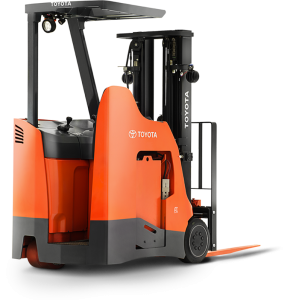Telehandler vs Forklift: What’s the Difference?

Forklift (Courtesy: ToyotaForklift.com)
For some people, the terms “telehandler” and “forklift” are interchangeable. But they actually refer to two very different types of industrial equipment.
So what’s the difference? And how can you tell if you need a telehandler or a forklift to maximize materials handling in your business? Here’s what you need to know.
Telehandlers — It’s Right There in the Name
The term “telehandler” is actually a type of abbreviation that stands for “telescoping handler”. The name refers to the boom that lifts the payload, which typically stems from the rear of the vehicle and telescopes to a shorter length when not fully extended.
While forklifts generally lift loads vertically, telehandlers offer a little more versatility in terms of the directionality of its lifting. Telehandlers make it easier to lift loads forwards and backward without having to move the vehicle. Forklifts, on the other hand, usually need to be physically driven forward or backward to achieve the same results.
Forklifts — Great for Warehouse Aisles

Telehandler (Courtesy: Wikimedia Commons)
Both forklifts and telehandlers can be used to lift and move heavy loads, including fully loaded pallets. And like forklifts, telehandlers can be fitted with a variety of attachments, including work platforms, hooks, grabbers, and more. But the type of vehicle you needs generally depends on how you plan to use it.
For example, forklifts are usually preferable for use inside warehouses or on docks. Because they are more compact, quick, and versatile — at least compared to telehandlers — forklifts are often ideal for zipping up and down warehouse aisles or moving products on and off trucks or rail cars.
Telehandlers, on the other hand, are generally better for outdoor use on rough terrain and for lifting loads to heights higher than the typical forklift can reach.
Forklift vs Telehandler — Boom, There It Is
If you are still confused about whether a vehicle is a telehandler or a forklift, all you really need to do is to look at its boom. The telehandler has a horizontal boom, making it look more like a mobile crane. A telehandler boom can lift a load to an angle from horizontal of about 70 degrees. Plus, the boom itself can be extended or retracted to lengths of up to 30 feet or more depending on the model.
This telescoping ability has led to some operators referring to the telehandler by the nickname “zoom boom”.
Compare that to the vertical boom of a forklift and the difference between the two types of industrial vehicles should be obvious: If it’s up and down, it’s a forklift. But if its up and down, side to side, and forward and backward, it’s a telehandler.
